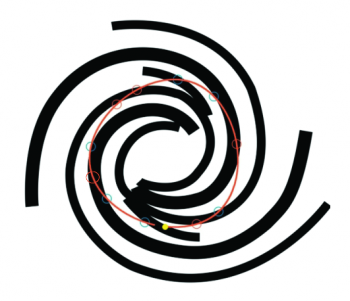
In a paper published today on the Los Alamos astro-ph preprint service, astronomers propose that as many as eleven past extinction events can be linked to the Sun’s passage through the spiral arms of the Milky Way. (You can download the paper here [pdf].)
A correlation was found between the times at which the Sun crosses the spiral arms and six known mass extinction events. Furthermore, we identify five additional historical mass extinction events that might be explained by the motion of the Sun around our Galaxy. These five additional significant drops in marine genera that we find include significant reductions in diversity at 415, 322, 300, 145 and 33 Myr ago. Our simulations indicate that the Sun has spent ~60% of its time passing through our Galaxy’s various spiral arms.
The figure on the right, from their paper, shows the Sun’s orbit in red over the last half billion years. The Sun’s present position is indicated by the yellow spot, and the eleven extinctions are indicated by the circles.
There are obviously a great deal of uncertainties in this conclusion. Most significantly, the shape and history of the Milky Way remains very much in doubt, especially since we reside within it and cannot really get a good look at it. Though in recent years astronomers have assembled a reasonable image of the galaxy’s shape — a barred spiral with two major arms and several minor ones — this picture includes many assumptions that could very easily be wrong.
Nonetheless, the paper’s conclusions are interesting.
» Read more

